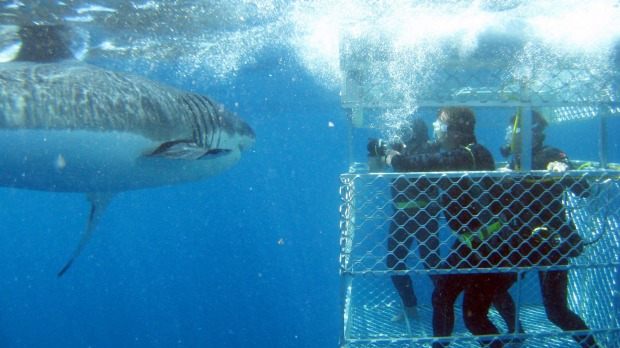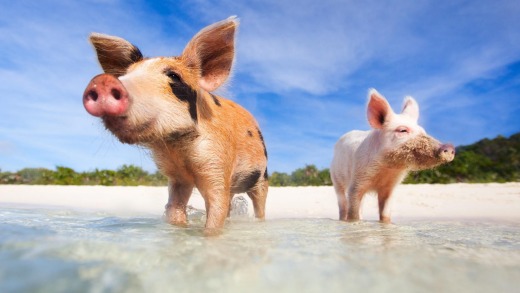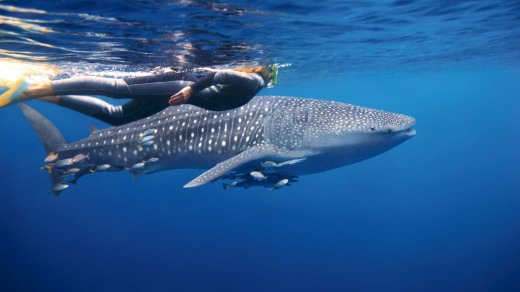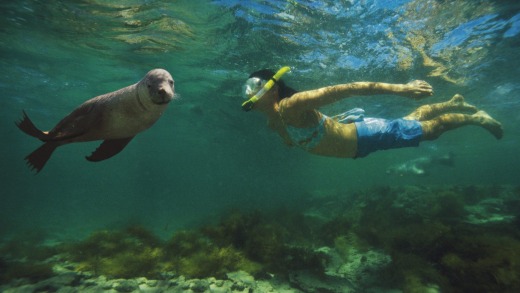
The Neptune Islands off South Australia's Eyre Peninsula are the only place in Australia where shark cage diving is permitted. The cage on the back of the boat is lowered into the water, swimmers are put inside breathing through regulators, and tuna gills are dangled in the water as bait. And then, seemingly from nowhere, the 1.2-metre great whites sidle alongside. See sharkcagediving.com.au.
It generally doesn't take long after Temptation Sailing's boat departs from Glenelg marina to find Adelaide's resident bottlenose dolphin populations. Once they're close, the wetsuit-clad swimmers slide off the back, and hold on to ropes. And hopefully the dolphins decide to swim alongside. When they do, it's a magic face-to-face viewing until they decide to jump up and peel off. See dolphinboat.com.au.
A similar system works off Mooloolaba on the Sunshine Coast, but Sunreef's tours are seeking humpback whales instead. When they're spotted, the boat gets to within 100 metres and the skipper cuts the engines. Swimmers grab hold of lines dangling out the back, and the whales are allowed to do their own thing. If they approach, it's entirely on their terms. See sunreef.com.au.

The biggest fish on earth – weighing up to 15 tonnes and getting up to 12 metres in length – are whale sharks. And they can be found hanging out off the Ningaloo Reef in Western Australia between April and July. Ningaloo Blue is among a number of operators that take swimmers out to meet the lovably docile giants from Exmouth. See Ningalooblue.com.au.
They look like the flamboyant, theatrical outcasts of the seahorse family, and flutter through the waters of Port Phillip Bay in a blaze of flailing colour. They can generally be found around the pier (or not far off) in Portsea towards the end of the Mornington Peninsula. Bayplay runs snorkelling tours. See bayplay.com.au.
Jones Island off the Eyre Peninsula's Baird Bay is a bit of a haven for Australian sea lions, and Baird Bay Ocean Eco Experience has been keeping an eye on them for more than a decade. Its tours allow guests to get in the shallow waters around the island, where the sea lions like to splash, play and generally grunt at each other. See bairdbay.com.

Crocosaurus Cove in Darwin offers the change to get unnervingly close to salties you'd run a mile from in any normal circumstances. Adventurous swimmers clamber into a see-through acrylic box within their enclosure, and what happens next depends on the mood of the five-metre-long toothy beasts. You might be ignored, but you might also get a full impact attack. See crocosauruscove.com.
The snorkelling on the reefs in Palau is arguably better than anywhere else on earth, but there's one marine lake where it gets mighty weird. It is full of jellyfish that have evolved not to sting, and while there are a few at the water's edge, by the time you get to the middle of the lake you're batting them away like you're in a giant, living ball pool. See samstours.com.
Nobody quite knows how a family of pigs got to the otherwise uninhabited Big Major Cay in the Bahamas, but they've grown to be quite friendly with passing boats. This means that daytrippers have the rather surreal opportunity to get in the water and interact with the feral but placid porkers. And the beach – now Pig Beach – has been named in their honour. See Bahamas.com/swimmingpigs.

Also out in the Caribbean, just off the coast of Antigua, is a shallow area where stingrays like to hang out. This is partially because they get fed by people coming out on the boats to see them, but they're remarkably gentle and puppy-esque. Expect a few frights while in the water, though – they have a habit of sneaking up from behind and softly brushing human legs. See stingraycityantigua.com.